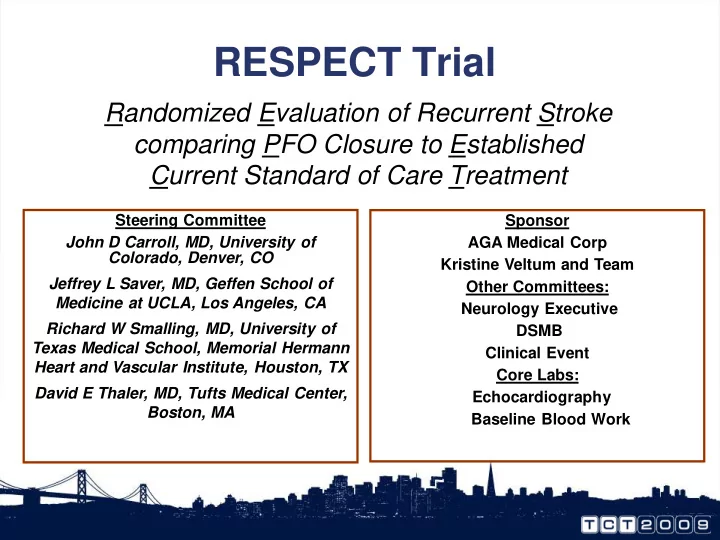

RESPECT Trial Randomized Evaluation of Recurrent Stroke comparing PFO Closure to Established Current Standard of Care Treatment Steering Committee Sponsor John D Carroll, MD, University of AGA Medical Corp Colorado, Denver, CO Kristine Veltum and Team Jeffrey L Saver, MD, Geffen School of Other Committees: Medicine at UCLA, Los Angeles, CA Neurology Executive Richard W Smalling, MD, University of DSMB Texas Medical School, Memorial Hermann Clinical Event Heart and Vascular Institute, Houston, TX Core Labs: David E Thaler, MD, Tufts Medical Center, Echocardiography Boston, MA Baseline Blood Work
Disclosure Statement of Financial Interest John D. Carroll, MD Within the past 12 months, I have had a financial interest/arrangement or affiliation with the organization(s) listed below. Grant/Research Support AGA Medical Consulting Fees/Honoraria AGA Medical
“The optimal therapy for prevention of recurrent stroke or transient ischemic attack in patients with cryptogenic stroke and patent foramen ovale has not been defined…Completion and peer review of ongoing trials are critical steps to establish an evidence base from which clinicians can make informed decisions regarding the best therapy for individual patients .” Circulation. 2009.
Clinical Trial Design • The RESPECT PFO Clinical Trial is a randomized evaluation comparing PFO device closure versus medical therapy. • Maximum 900 patients (450 per arm) • Recent cryptogenic stroke (270 days) • 18-60 years of age • Maximum 75 participating institutions across the U.S. and Canada (60 approved sites)
Randomization Groups • Device closure plus medical therapy • AMPLATZER PFO Occluder • Clopidogrel for one month • Aspirin for six months • Discontinuation of the drug is at the discretion of the Investigator. • Medical therapy (SOC) Current standard of care: one of the four treatments: • Aspirin alone • Warfarin alone • Clopidogrel alone • Aspirin in combination w/ dipyridamole
Study Endpoints Primary Endpoint: • Recurrence of a Nonfatal Stroke, Post-randomization Death, or Fatal Ischemic Stroke Secondary Endpoints: • Complete closure of the defect demonstrated by TEE and bubble study at 6-month follow-up (device group) • Absence of TIA
Statistical Design • Design is “Event Driven” Total number of patients is not considered — only number of endpoint events. • Four stopping rules are derived, which will be implemented based on number of PFO vs. number of SOC events • Success will be declared if a positive stopping rule is reached, that is, a pre-defined stopping rule is obtained and the device is significantly better than SOC
RESPECT Current Status: 2009 Baseline Characteristics of Enrolled Patients
Enrollment by Year Thru end of second quarter 2009 700 576 600 522 500 Number of Subjects 389 400 259 300 148 200 61 100 4 0 2003 2004 2005 2006 2007 2008 Q2 2009
RESPECT Investigational Sites All site locations Top Ten Enrolling Sites • South Denver Cardiology • Medical College of Wisconsin • Tufts Medical Center • UT Houston/Memorial Herman Hosp • Univ. of Colorado • Duke University • Univ of Washington • OSF St. Francis Medical Center • Washington Hospital Center • Ohio State University
Baseline Data as of June 30, 2009 Number of Subjects: 576 Male: 57.7% Female: 42.3% N Mean SD Range Age: 575 45.4 9.8 (18, 60) 572 89.3 62.2 (1, 265) Days since CVA:
Baseline Medical History Migraine: 37.4% Previous TIA: 12.0% Palpitations: 8.7% Sinus Bradycardia: 7.4% CAD: 3.5% DVT: 3.5% Sinus Tachycardia: 1.6% COPD: 1.4% Previous MI: 1.2% Peripheral Vascular Disease: 0.9% Congestive Heart Failure: 0.2% Unstable Angina: 0.2%
Baseline Risk Factors Hypercholesterolemia: 37.9% Family Hx of Ischemic Heart Disease: 32.9% Hypertension: 31.1% Family Hx of Stroke: 27.1% Current Smoker: 12.9% Diabetes: 7.5% Substance Abuse: 1.2%
NIH stroke scale scoring system and RESPECT patients at time of enrollment : Scale RESPECT Patients • 0= no stroke • N = 570 • 1-4= minor stroke • NIH Stroke Scale: • 5-15= moderate stroke Mean 0.8 • 15-20= moderate/severe stroke SD 1.7 • 21-42= severe stroke Range 0-17
Baseline Neuroanatomic CVA Cortex Location Frontal: 26.8% Parietal: 24.8% Centrum Semiovale: 8.6% Temporal: 15.7% Internal Capsule: 5.2% Occipital: 14.9% Basal Ganglia: 10.1% Thalamus: 14.0% Cerebellum: 15.2% Brain Stem: 5.6%
Baseline CVA Vascular Territory MCA: 51.8% ACA: 2.6% PCA: 19.9% Basilar: 7.5% Vertebral: 5.4% Anterior Choroidal: 0.7% Other: 6.7%
Baseline Size of Lesion (MRI or CT) Longest linear diameter Small: 16.7% Intermediate: 30.3% Moderate: 25.0% Large: 20.2% Massive: 4.2% Size Not Reported: 3.6% (Data pending)
Baseline PFO Shunt Assessment per TEE with Agitated Saline Shunt at Rest: 85.7% Shunt at Valsalva: 97.7%
Assessment of Shunting Resting State 3% 14% • Grading: Number of microbubbles in left atrium within 3 beats 35% Grade 1: 1-9 25% Grade 2: 10-20 Grade 3: >20 23% Grade 0 Grade 1 Grade 2 Grade 3 Not Assessed
Assessment of Shunting Valsalva 1% 13% • Grading: Number of microbubbles in left atrium within 3 beats 13% 46% Grade 1: 1-9 Grade 2: 10-20 Grade 3: >20 27% Grade 0 Grade 1 Grade 2 Grade 3 Not Assessed
Atrial Septal Aneurysm Data not core lab adjudicated ASA Frequency in All ASA Size Patients % of All ASA Atrial Septal Aneurysm: 34.8% No Atrial Septal Aneurysm: 65.2% _________________________ ASA Excursion Direction 24% 10-12mm RA 8% 56% 13-15mm LA 32% 20% >15mm Both 60%
Randomization Randomization Device: 291 (50.5%) Medical Mgmt: 285 (49.5%) Stratification Aspirin alone: 240 (42.1%) Coumadin alone: 167 (29.3%) Clopidogrel alone: 57 (10.0%) Aspirin w/ dipyridamole: 106 (18.6%)
Conclusions • RESPECT continues to enroll at a reasonable pace. • A substantial number of patients have been enrolled to date. Represent a spectrum of patients in terms of CVA and PFO characteristics. • Substantial number with “high risk” PFO characteristics – Baseline right to left shunting (85.7%) and atrial septal aneurysm (34.8%). A relatively “pure” population free of confounding clinical comorbidities. • RESPECT will end when a stopping point is achieved.
Recommend
More recommend